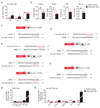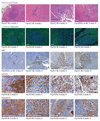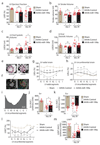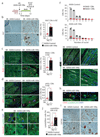MicroRNA therapy stimulates uncontrolled cardiac repair after myocardial infarction in pigs
- PMID: 31068698
- PMCID: PMC6768803
- DOI: 10.1038/s41586-019-1191-6
MicroRNA therapy stimulates uncontrolled cardiac repair after myocardial infarction in pigs
Abstract
Prompt coronary catheterization and revascularization have markedly improved the outcomes of myocardial infarction, but have also resulted in a growing number of surviving patients with permanent structural damage of the heart, which frequently leads to heart failure. There is an unmet clinical need for treatments for this condition1, particularly given the inability of cardiomyocytes to replicate and thereby regenerate the lost contractile tissue2. Here we show that expression of human microRNA-199a in infarcted pig hearts can stimulate cardiac repair. One month after myocardial infarction and delivery of this microRNA through an adeno-associated viral vector, treated animals showed marked improvements in both global and regional contractility, increased muscle mass and reduced scar size. These functional and morphological findings correlated with cardiomyocyte de-differentiation and proliferation. However, subsequent persistent and uncontrolled expression of the microRNA resulted in sudden arrhythmic death of most of the treated pigs. Such events were concurrent with myocardial infiltration of proliferating cells displaying a poorly differentiated myoblastic phenotype. These results show that achieving cardiac repair through the stimulation of endogenous cardiomyocyte proliferation is attainable in large mammals, however dosage of this therapy needs to be tightly controlled.
Conflict of interest statement
Figures















Comment in
-
MicroRNA-directed cardiac repair after myocardial infarction in pigs.Nat Rev Cardiol. 2019 Aug;16(8):454-455. doi: 10.1038/s41569-019-0216-z. Nat Rev Cardiol. 2019. PMID: 31127255 No abstract available.
References
Publication types
MeSH terms
Substances
Grants and funding
LinkOut - more resources
Full Text Sources
Other Literature Sources
Medical

